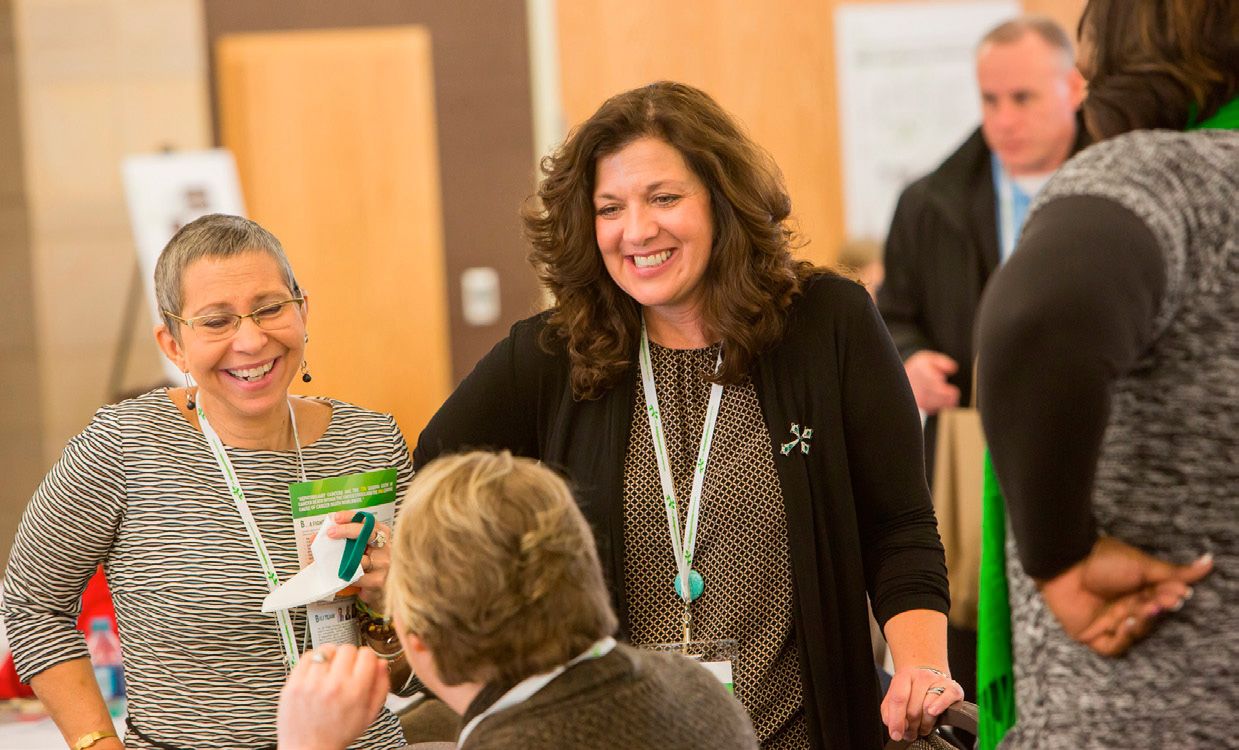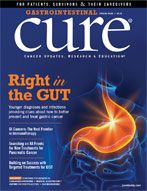Publication
Article
CURE
Cholangiocarcinoma Research is Expanding, But Many Questions Are Still Unanswered
Author(s):
Research into treatments for cholangiocarcinoma is branching out, but there are still more questions than answers.
“MELINDA BACHINI (center), whose cholangiocarcinoma has responded to immunotherapy, mingles with attendees at the Cholangiocarcinoma FoundationAnnual Conference. PHOTO BY BARR PHOTOGRAPHY (COURTESY OFTHE CHOLANGIOCARCINOMA FOUNDATION”

MELINDA BACHINI (center), whose cholangiocarcinoma has responded to immunotherapy, mingles with attendees at the Cholangiocarcinoma Foundation Annual Conference. PHOTO BY BARR PHOTOGRAPHY (COURTESY OF THE CHOLANGIOCARCINOMA FOUNDATION)
Back in 2009, Melinda Bachini thought her job as a paramedic explained all her physical complaints — an irritable stomach from eating at odd times, exhaustion from working 24-hour shifts, right shoulder pain from lugging medical equipment.
The mother of six was dumbfounded when it turned out her symptoms were the result of a grapefruit-sized tumor in her liver. It took a while, but her doctors figured out that the mass was cholangiocarcinoma, a cancer she’d never heard of in her life. Even after treatment with surgery, Bachini was told she faced a 76 percent chance that the bile-duct cancer would recur.
When it did, in her lungs, Bachini was faced with another challenge: She wanted to join a clinical trial, but first had to convince the governor of her home state, Montana, to sign a bill requiring health insurers to cover routine patient costs associated with participating in such trials.
It was a frustrating diversion, but a fateful one. After the bill was signed and she had undergone chemotherapy, Bachini learned about a trial of a treatment that uses a patient’s own immune cells to fight cancer. In adoptive T cell therapy, researchers harvest immune cells that are naturally programmed to fight the patient’s cancer, multipy them in a lab and then reinfuse the microscopic army back into the patient’s body.
Bachini joined the trial at the National Cancer Institute and spent a month in the hospital as her immune system geared up. When she went home, she recalls, “things started improving right away. My chronic cough went away. I could walk my dog. Day by day, everything was better — it was incredible.”
The treatment didn’t cure Bachini’s cancer, but it shrank her tumors and kept the disease at bay, without any other therapies, for 18 months. Then doctors at the NCI treated her again, focusing this time on T cells targeting a specific mutation in the protein ERBB2IP, which they knew was present in her tumor. With only recent mild tumor growth, she’s been doing well for the past 28 months.
A six-year survivor of cholangiocarcinoma, Bachini is an exceptional responder, even among the 11 others in the trial. Typically, patients with advanced cholangiocarcinoma face a very poor prognosis.
But Bachini, who now works as an advocate with the Cholangiocarcinoma Foundation to offer fellow patients hope, says her experience has convinced her that “every day holds the possibility of a miracle.”
PICKING UP SPEED
To achieve that miracle, more attention to cholangiocarcinoma is needed, and that’s been coming in increasing doses.
In recent years, pharmaceutical companies have become more willing to offer up drugs for study in the disease diagnosed in 6,000 Americans each year, which is now treated mainly with surgery, chemotherapy and radiation. At the same time, more researchers have become committed to finding answers, and patients like Bachini have expressed an avid interest in participating in clinical trials, attendees explained during the Cholangiocarcinoma Foundation Annual Conference held in Salt Lake City, Utah, in early February.
“If you look back to 1949, there was one paper published for cholangiocarcinoma,” said Juan Valle, an oncologist and researcher with the Christie NHS Foundation Trust in England who was on hand to give attendees a research overview. “As time has gone by, there have been more and more papers published due to a greater scientific interest in cholangiocarcinoma, even within the last five years. A total of 536 papers were published in 2011, there were 918 in 2015 and I suspect that will continue to increase.”
All kinds of solutions are being explored: liver transplant, new chemotherapy combinations, chemotherapy before or after surgery, updated radiation approaches, targeted treatments and immunotherapies.
So far, though, there have been no eye-popping results. Scientists are learning more every day about the genomic variability of cholangiocarcinoma and how it responds — or doesn’t — to various types of treatments. But for now, they remain awash in more questions than answers.
WHAT IS CHOLANGIOCARCINOMA?
Cholangiocarcinoma affects the bile ducts, tubes from the liver to the small intestine that carry bile, a fluid that helps digest fats and excrete wastes.
Half of all cholangiocarcinomas are perihilar, meaning that they occur where the left and right hepatic ducts meet upon leaving the liver. Because they occur outside the liver, these are considered extrahepatic bile duct cancers, as are distal cancers, which happen further down the duct near where it connects to the small intestine, and comprise two to three of every 10 cholangiocarcinomas.
Rarest, about one in every 10 cholangiocarcinomas, are intrahepatic cancers, which occur in smaller bile duct branches inside the liver.
Risk factors include age over 65; obesity; diabetes; inflammatory conditions including hepatitis B and C, HIV and inflammatory bowel disease; congenital abnormalities; infectious diseases such as liver flukes, which are most common in Asia; and a list of drugs, toxins or chemicals, including the radioactive Thorotrast, which in the past was used in X-rays, as well as asbestos and dioxin. Smoking and drinking alcohol are also thought to be risk factors.
All of that is “important, because a number of these we might be able to do something about,” Valle said. “In reducing the incidence of cholangiocarcionoma, we also need to focus on some of these preventive measures.”
There is no screening method for finding cholangiocarcinoma, and symptoms — which can include yellowed skin known as jaundice, itching, discolored urine or stools, belly pain or vomiting — don’t typically occur until the disease is advanced.
Five-year survival for those with intrahepatic cholangiocarcinomas is 15 percent if the cancer was localized when found, but drops down to 2 percent if it was distant. Five-year prognoses are a bit better for those with extrahepatic cholangiocarcinomas: 30 percent when localized at diagnosis, but still 2 percent if the cancer was distant when found.
“Surgery is the only chance of cure, but that’s usually not possible because the disease is too advanced” or patients, who are older, have additional illnesses that make treatment more difficult, Valle said.
THE STANDARD OF CARE
Sometimes radiation and/or chemotherapy are used to shrink tumors so that they are small enough to operate on, or these techniques may be used after surgery to help control cancer. Radiation therapy can also be the main treatment, if surgery is not possible.
But the backbone of treatment for metastatic cholangiocarcinoma is combination chemotherapy with cisplatin and gemcitabine, the only regimen formally shown to improve survival.
“This is a devastating disease,” Valle said. “If we don’t do anything but give best supportive care alone, survival is twoand- a-half to four-and-a-half months. With cisplatin and gemcitabine, on average, patients survive a year. That’s still modest, but having a single standard of care allows us to be able to build on that, to add new treatments we want to explore.”
WHAT’S NEXT?
A host of techniques are, in fact, being studied, but many with less-than-optimal or uncertain results.
Transplant
Liver transplant would ostensibly allow surgeons to avoid the tricky issues involved with excising tumors: conserving blood supply to the liver, getting clean margins and leaving behind an organ that is functional.
However, “it’s fair to say that initial results from transplantation have been disappointing — five-year survival was less than 50 percent,” Valle said. “This has improved to 65 to 80 percent with recent neoadjuvant approaches before transplant, but treatment is intensive,” including radiation, chemotherapy and laparoscopy before transplant to make sure the cancer hasn’t spread.
Valle cautioned that existing data is for patients with earlystage disease, making it more difficult to evaluate the success of transplantation. That’s because some early-stage patients, during surgery, were found to have no evidence of cancer, and it wasn’t possible to know whether their tumors had completely resolved due to pre-transplant radiation/chemotherapy or whether the patients had never had tumors in the first place.
Valle also cautioned that patients on waiting lists don’t always get new livers in time, and when those who die while waiting are included in statistics, the success rate with transplant drops back down to 53 percent.
Still, a number of transplant studies in cholangiocarcinoma are being conducted in the U.S. (NCT00301379), Italy, China and France.
Adjuvant and Neoadjuvant Therapy
With transplant a shaky option, patients with earlier-stage disease can expect to undergo liver resection. Might they stand a better chance of cure if they got radiation or chemotherapy after surgery?
It’s a difficult question to answer, Valle says. The bottom line is that some patients are going to either be cured or relapse, regardless of whether they undergo adjuvant therapy. Only for a small population of patients might post-surgery therapy turn a likely relapse into a cure.
To make matters worse, Valle said, “we can’t tell ahead of time who those patients are. We don’t know how big that group is. Is it different for intrahepatic or extrahepatic cholangiocarcinoma?”
The only way to find out is by conducting randomized clinical trials, and that’s being done, Valle said. Close to reporting results is BilCap, conducted in the U.K., which recruited 360 patients and treated half with surgery alone and half with surgery plus adjuvant chemotherapy (capecitabine). Also preparing to report results is the PRODIGE12 study in France, which compared surgery with or without adjuvant gemcitabine and oxaliplatin.
A third study recently opened in Germany: ACTICCA-1, which is comparing cure-intended surgery alone versus surgery plus cisplatin and gemcitabine.
The concept of treatment with other modalities before surgery — neoadjuvant therapy — was first explored in breast cancer, where it is now a standard of care, and has been studied a lot in pancreatic cancer, noted Kabir Mody, an oncologist specializing in gastrointestinal cancers at the Mayo Clinic who discussed clinical trials in a presentation at the conference. In cholangiocarcinoma, because this tactic can shrink tumors, it might be appropriate for patients with disease that is resectable or nearly so, and those are the patients now enrolled in a pilot study of gemcitabine and cisplatin before surgery.
“It’s an area that needs more exploration,” Mody said. “It’s not clear what the best chemotherapy regimen would be.”
Radiation Therapy
In radiotherapy, questions revolve around how doctors can administer higher doses and target tumors more accurately while reducing side effects and complications, Valle said.
Studies are looking at radiation with or without chemotherapy and analyzing dosage, schedules, local control, survival and toxicity, he said.
In the U.K., the phase 2 ABC-07 study will administer cisplatin/ gemcitabine to patients with tumors of 6 centimeters or less for three months, then split responders into two groups — one remaining on chemotherapy and the other additionally receiving stereotactic body radiotherapy (SBRT).
Also being explored is proton beam therapy, offered by only a handful of centers in the United States. It’s billed as a technique that delivers less radiation to healthy tissue around a tumor, thus causing fewer side effects.
In a single-arm, phase 2 study, 39 patients with non-metastatic intrahepatic cholangiocarcinoma experienced an average overall survival of 22.5 months after proton beam therapy, with few serious side effects — apparently better results than chemotherapy, Valle pointed out. A next study (NCT02200042) will start with a cisplatin/gemcitabine induction period and then add focal radiation therapy for some patients. “We will get to find out what is the extra value that proton beam or SBRT add, if at all,” Valle said.
Also being considered in intrahepatic cholangiocarcinoma is selective intra-arterial radiotherapy (SIRT), which delivers radiation on beads small enough to be injected into tumors.
In an analysis of 11 retrospective or prospective studies including nearly 300 pretreated patients, this technique shrank 28 percent of cholangiocarcinoma tumors and resulted in stable disease for 54 percent of patients; 10 percent of the tumors shrank enough to be operable. Average overall survival on the treatment was 15.5 months. However, the therapy caused fatigue, abdominal pain, fever, nausea and abnormal liver tests, as well as one treatment-related death.
“We’ve learned over the past few years to do this much more safely,” Valle said. “The important thing is to give just enough to treat the tumor but not enough to allow the liver to fail.”
An upcoming randomized phase 2 trial, SIRCCA, will start off some patients with standard chemotherapy and others with the beads followed by chemotherapy, Valle said. “We’ll really get to understand how much these radiotherapy beads add over and above chemotherapy alone.”
A different study, Mody said, will compare SIRT to TACE, or trans-arterial chemoembolization, which uses beads coated with chemotherapy instead of radiation.
Also being looked at by researchers, he said, is irreversible electroporation, which uses electrical fields to create pores in tumor cells, allowing fluids to move in and out that will eventually kill the cells by bursting their membranes.
Chemotherapy
Although standard chemotherapy with gemcitabine/cisplatin has remained unchanged in the past few years, there are suggestions that more patients with cholangiocarcinoma can benefit from it. A recent clinical trial demonstrated benefit in 33 patients with jaundice who were otherwise fit; in the past, they would have been excluded from therapy. “Jaundice can be life-threatening in three to four weeks, but these patients could live close to 10 months with the cisplatin/gemcitabine combination,” Valle said. He cautioned, though, that “that only applied if they had a tumor blocking off the bile ducts, because they could then get an improvement and their ducts drained beter. It did not work if the liver was very badly damaged already.”
Newer ways of administering chemotherapy are also being explored. Hepatic artery infusions use a pump on the surface of the abdomen to deliver chemotherapy directly to the liver through a catheter inserted into the hepatic artery. Two studies on this technique are being done at Memorial Sloan Kettering Cancer Center, Mody said.
What about new chemotherapy combinations? Is there anything out there better than cisplatin and gemcitabine? Valle says chemotherapy doublets and triplets are being explored in cholangiocarcinoma in the United States, including the modified FOLFIRINOX regimen used in pancreatic cancer, and cisplatin and gemcitabine combined with 5-fluorouracil. Another study is adding Abraxane (nab-paclitaxel), which has worked well in pancreatic cancer, to cisplatin/ gemcitabine, noted Mody. Another potential addition to regimens is Acelarin (NUC- 1031), which is similar to gemcitabine but expected to cause fewer side effects. That’s shown a “hint” of promise in a phase 1 study, and is being looked at in another early trial, Valle said. Since chemotherapy doesn’t kill all cancer cells, the bad news is that it can be expected to stop working at some point. And then what?
“We don’t really have good backup options,” Valle said. “For second-line chemotherapy, our team looked at all trials of all treatments to get a sense of how effective they were. We found quite a few studies that included close to 900 patients altogether, treated with a long list of different options, and it was disappointing that we weren’t able to come up with a conclusion regarding the best approach. One thing we found was that the amount of time that the chemotherapy controlled the cancer was probably only until the first scan — they were not very effective treatments, and we need to do better in second-line.”
In the ABC-06 study of secondline chemotherapy versus active symptom control, investigators are considering whether chemotherapy is even the right approach as a second-line treatment. “Often, patients run into problems with recurrent infections and needing a stent and a second stent,” Valle said.
Targeted Therapies
With scientists understanding more about the biology of various cancers, there is, of course, interest in applying targeted therapies in cholangiocarcinoma.
But in this area, too, there’s still a lot of work to be done. So far, drugs targeting mutations in the EGFR pathway, which occur in a number of cancers, have not shown benefit in cholangiocarcinoma. Also without benefit was cediranib, an experimental anti-angiogenesis drug that stops blood vessels from growing and feeding tumors, “but one problem is that adding cedirinib to standard chemotherapy added more side effects,” Valle pointed out. “Maybe we should look at a different compound that has less side effects if we want to see the benefit.”
Going forward, more distinct classification of cholangiocarcinoma subtypes may help direct the use of targeted therapy, Valle suggested.
“Intrahepatic cholangiocarcinoma has a different genomic profile than extrahepatic cholangiocarcinoma. If you look at extrahepatic, KRAS substitution (a cancer-causing mutation that activates cell growth pathways) is 42 percent — much higher than in other cancers. Is there something about these different patterns that will allow us to treat patients differently?” In that vein, a couple of techniques are being tested specifically in intrahepatic cholangiocarcinomas, due to their unique genomic codes.
One strategy is to target the FGFR2 receptor, which sends pro-growth signals to cells. Scientists now know that 11 to 15 percent of intrahepatic cholangiocarcinomas have a misplaced FGFR2 receptor gene, leading to overexpression of the protein that promotes the growth of cancer cells instead of normal ones. Based on this knowledge, there are a number of phase 1 and 2 trials testing FGFR inhibitors in intrahepatic cholangiocarcinoma, including phase 2 trials of Iclusig (ponatinib), a drug indicated for the treatment of chronic myelogenous leukemia, Mody said.
In addition, 15 to 20 percent of patients with intrahepatic cholangiocarcinoma have mutations in the IDH1 or IDH2 genes, causing the genes to secrete pro-tumorogenic substances. Targeting these mutant proteins are some novel drugs, including AG120. Last year, a small phase 1 trial showed that AG120 was well-tolerated, and one of 20 participating patients with cholangiocarcinoma had a partial response; 11 patients had stable disease on the drug, and six of them maintained that response beyond six months, Mody said.
“There’s some promise there, and a phase 2 trial is being planned and will be started soon,” he said.
Immunotherapy
Despite the success that immunotherapy has brought Bachini, such techniques are still little-studied in cholangiocarcinoma.
There are only two immunotherapy trials open that include patients with cholangiocarcinoma, Mody said, one testing Keytruda (pembrolizumab) in solid tumors (KEYNOTE-158) and the other weighing adoptive T cell transfer, which involves engineering a patient’s own immune cells to attack a specific target on cancer cells and then reinfusing them into the body to do their work.
An area of interest in immunotherapy is mismatch repair, or microsatellite instability, which is present in about 5 percent of cholangiocarcinomas. This condition prevents the repair of cellular “cuts and bruises,” allowing mutations to accumulate. This, in turn, makes these cells easier for the immune system to recognize, so they are particularly ripe for targeting with immunotherapy.
In a study of PD-1-targeted immunotherapy in patients with noncolorectal GI cancers, two of three participating patients with biliary cancers experienced durable responses, with survival significantly prolonged.
“It’s early data, but promising,” Mody said.
SLOW, BUT MEANINGFUL
Progress has been slow, but the research happening in each area of interest represents a start. In the eyes of those eager to significantly extend life, it’s not enough, but the activity stands in stark contrast to the way things were when Valle joined the field.
“I spent the early part of my 16 years in this field sending letters of intent to (pharmaceutical) companies to get somebody to please share their drugs, so we could open trials and start treating patients with new compounds,” he recalled. “It’s refreshing to see some people from industry here today, and to see trials led by the (pharmaceutical) industry making accessible to us some agents we wanted access to.”





